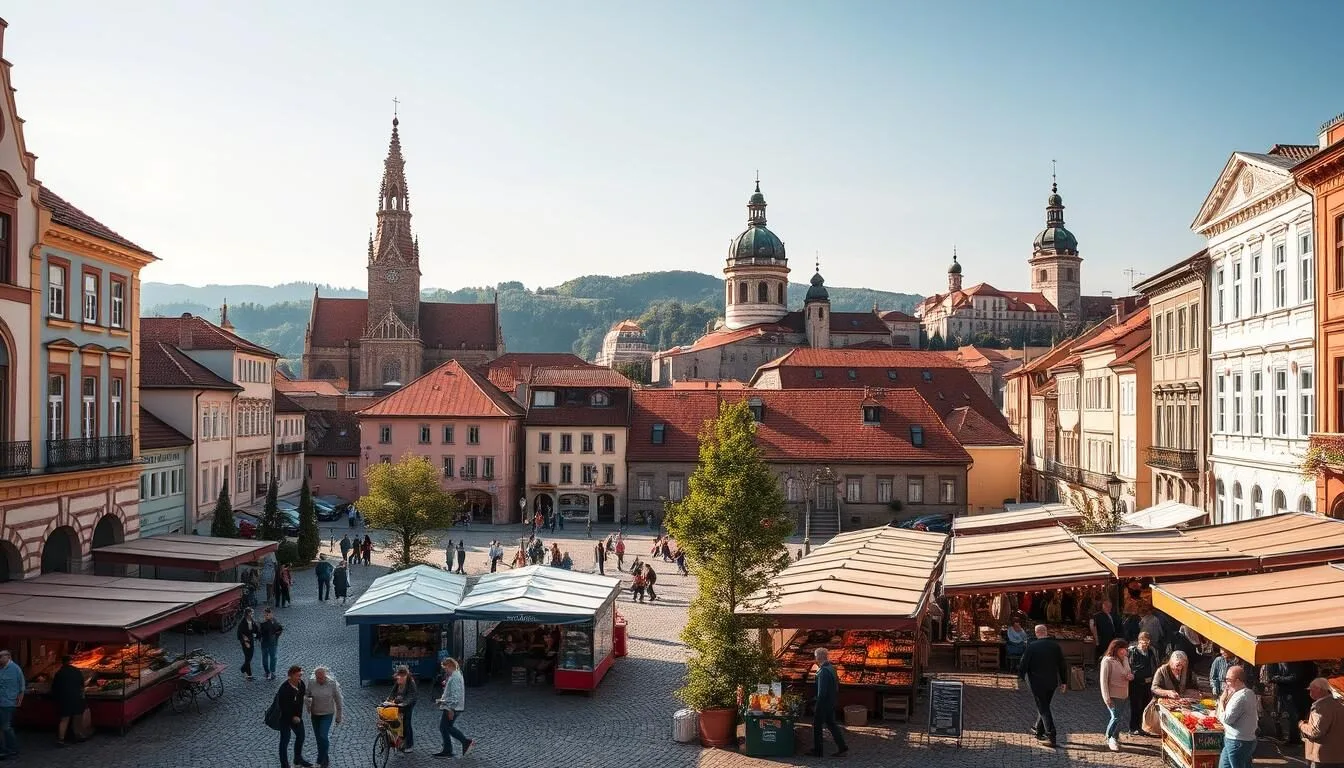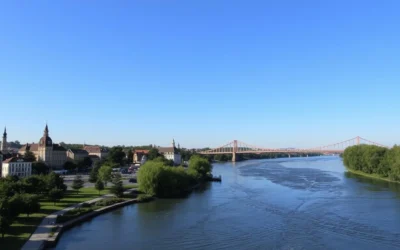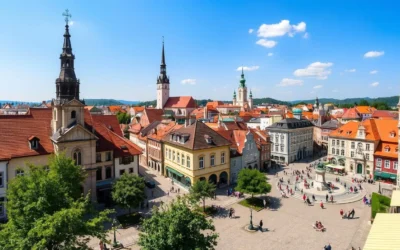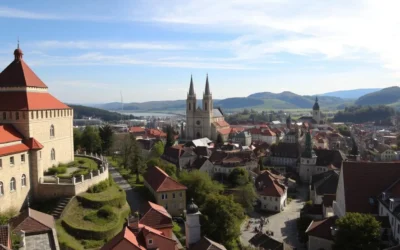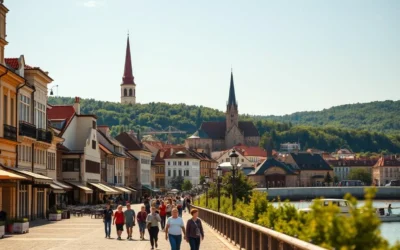Did you know this former capital once crowned Hungary’s kings and still hides a royal sarcophagus under a quiet garden?
This compact city rewards quick arrivals with a surprising depth of history and lively streets. You can wander the Old Town, pause at the Ruins Garden, and find cafés that invite slow conversations.
In this guide, you get an easy-to-use snapshot that points you to standout attractions, a recommended restaurant, and simple tips so you can start exploring today.
The layout keeps everything close: colorful Baroque lanes, the Town Hall square, and the Mausoleum sit within walking distance. That means more sightseeing and less transit stress when you travel.
Ready to explore? Drop your bag, step outside, and let the royal sites, charming bars, and local flavors show you why this destination offers plenty for curious visitors.
Szekesfehervár, Hungary: Best Things to Do – Top Picks
Getting here is quick: frequent direct trains from Budapest Déli station reach the city in about 45–60 minutes. Many services continue on toward Lake Balaton, so this stop fits neatly into longer travel plans.
Getting there from Budapest and Lake Balaton
- Trains run roughly three times an hour most of the day, giving you flexible departure options.
- The station sits nearly 2 km from the center — plan a 20–25 minute walk or catch a cash-only city bus into town.
- For Bory Castle, take local bus 26A or 32; allow extra time for the round trip.
- Buy tickets on the Hungarian Railways website or at the station to keep your schedule simple.
Is this a day trip or an overnight for you?
You can see core highlights in a relaxed day trip and enjoy a long lunch without rushing. If you stay overnight, you get an evening stroll through the center and a calm morning for one more museum or spa visit.
Walk the coronation core and royal landmarks
Begin your walk where crowns and graves once shared the same stone—the coronation core offers a concentrated slice of royal history. Stroll at a relaxed pace and you will find layers of story in a very small area.

Ruins Garden and Mausoleum: Saint Stephen’s sarcophagus and the medieval basilica
The medieval coronation church was first mentioned in 1031 and hosted coronations for 38 kings. You can see where St. Emeric was buried and learn that St. Stephen planned the basilica as his resting place.
The church burned in 1601. Excavations started in 1862 and, in 1938, Géza Lux designed the mausoleum and archway that now display the sarcophagus linked to St. Stephen.
Town Hall, the Orb, and certified Holy Crown copy
Cross to Városház Square to view Béla Ohmann’s Orb fountain, held aloft by three lions and marked with the dates 1001, 1688, and 1938. It’s a compact spot that summarizes civic milestones.
Visit Tourinform inside the Town Hall to see a certified copy of the Holy Crown—an ornate piece set with pearls, sapphires, and enamel images—and the Vilmos Aba-Novák mural nearby.
Bishop’s Palace and the historic main square atmosphere
The Bishop’s Palace and Diocese Museum frame the square and give the place a quiet, ecclesiastical edge. This center blends royal, religious, and civic life into an easy walking loop.
- Start your day at the Ruins Garden and give yourself a bit of extra time for panels and context.
- Pair this short circuit with a branch of the King St. Stephen museum later in the day for fuller context.
| Site | Why visit | Quick note |
|---|---|---|
| Ruins Garden | Coronation and royal burials; mausoleum display | Excavations shown since 1862; archway 1938 |
| Városház Square | Orb fountain marking civic dates | Symbols: 1001, 1688, 1938 |
| Town Hall | Holy Crown copy and Aba-Novák mural | Visit via Tourinform for access |
| Bishop’s Palace | Diocese Museum and historic façades | Frames the main square |
Explore Bory Castle, a whimsical artist-built fortress
Perched on Öreghegy, bory castle grew like a sculpture you can walk through—an intimate monument to one artist’s life and love.
Jenő Bory built the complex between 1923 and 1959 without formal plans. The project centers on a chapel of marital love and his working studios. Over time it became seven towers, roughly thirty rooms, and winding terraces.
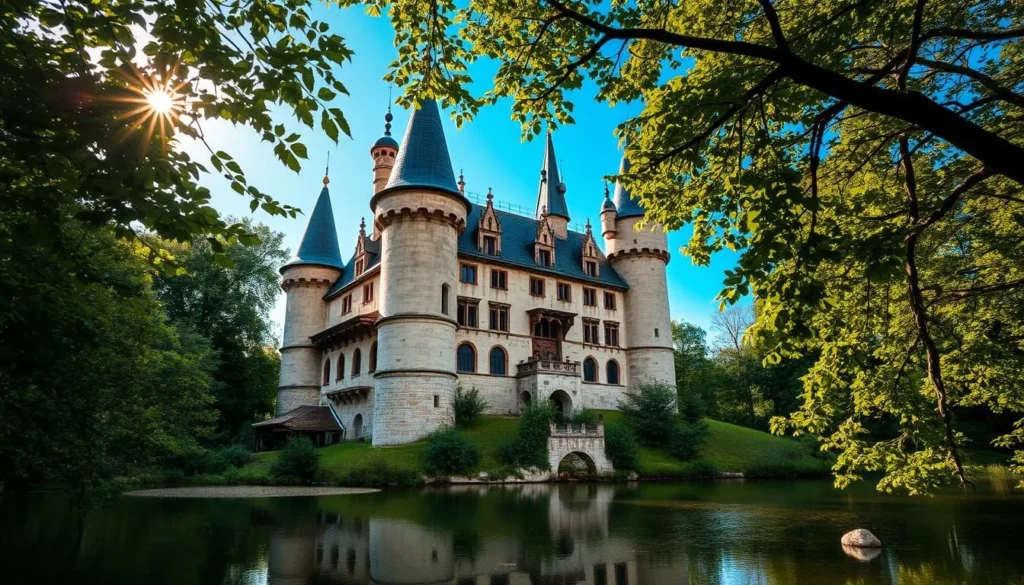
Don’t-miss highlights: towers, hundred-column court, sculptures, and views
Climb a viewing tower for broad perspectives; the vertical shift from dungeon to top is about 30 meters. Wander the hundred-column court lined with statues of national heroes and kings.
- You’ll spot mixed style cues—Gothic arches, romantic flourishes, and personal motifs that make each corner photo-ready.
- Corridors showcase mosaics, glass paintings, and ornamental fountains that surprise as you move through the area.
- City buses 26A or 32 connect the center to this off-center spot, making a half-day excursion simple.
- If you want context, check for short onsite tours or local guides who explain Bory’s symbolism and workshops.
Plan 60–90 minutes but allow more time if you linger on terraces or sketch details. This castle remains one of the city’s most photogenic attractions and rewards slow, curious exploration.
Can’t-miss museums for history lovers
History lovers can pack several focused museum visits into a single day without long walks between sites. The choices are compact and easy to pair with a coffee or lunch break.
King St. Stephen Museum: heritage-rich insights
The King St. Stephen Museum anchors multiple branches across the center. These well-curated places rotate exhibits that bring royal and civic stories to life.
Black Eagle Pharmacy Museum: 17th-century apothecary charm
Step into the city’s first pharmacy, opened in 1688, and see original cabinetry and tools. The display offers a rare, everyday window into past life that feels immediate and real.
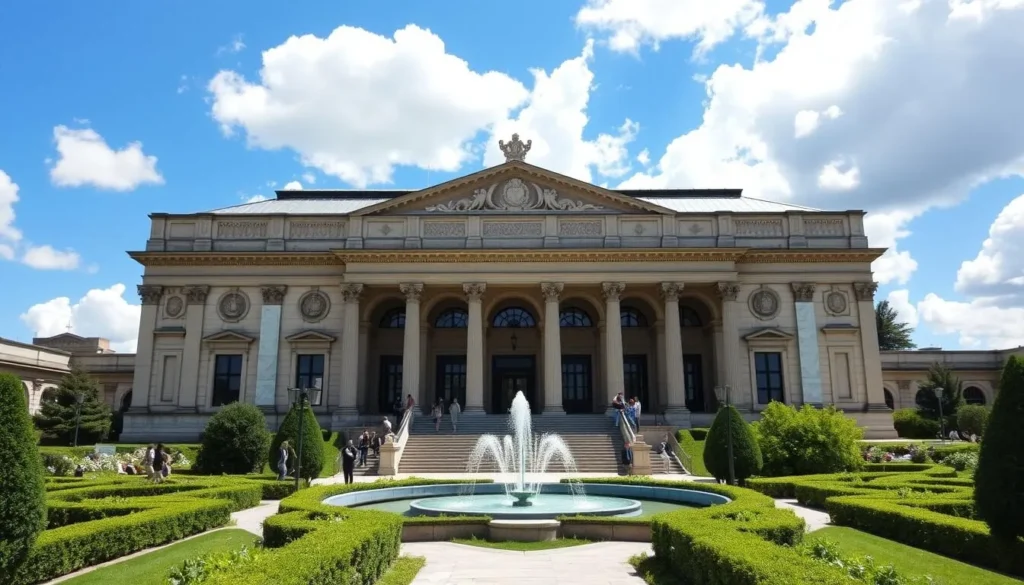
Clock Museum and musical carillon figures
The Clock Museum shows hundreds of timepieces, including a 17th-century tower mechanism that delights detail-oriented enthusiasts. Book tickets in advance if you plan to visit inside.
- The outdoor musical carillon performs at 10:00, 12:04 (after church bells), 14:00, 16:00, and 18:00 with traditional melodies.
- These compact museums let you see plenty without losing momentum on your city walk.
- They are family-friendly and easy stops when weather changes or you want indoor culture.
Churches and sacred sites that shaped a nation
A short walk connects a string of churches that hold centuries of art, power, and memory. These landmarks form a compact circuit you can follow today to trace royal ritual and daily devotion.
Székesfehérvár Basilica (built 1758–1768 on earlier medieval foundations) dazzles with Johann Cymbal frescos and a main altarpiece by Vincenz Fischer. Descend to the crypt to see the stone sarcophagus of Béla III and Anna of Antioch—a solemn date in the city’s burial history.
Saint Stephen Cathedral was rebuilt in 1777 on older ground. Seek the revered skull relic of Saint Stephen, a focal point for pilgrims and a notable piece of religious history.
Saint Anna Gothic Chapel is a rare medieval survivor. It endured the Ottoman era by serving as a Muslim prayer house, which helped preserve its Gothic fabric for modern visitors.
Székesfehérvári Magyarok Nagyasszonya-templom rewards an early visit. You’ll enjoy quieter pews and clearer light before crowds gather later in the day.
- Step into these churches for art, quiet, and a clear sense of how faith and monarchy intersected.
- Dress respectfully, check service times, and expect limited photography during worship.
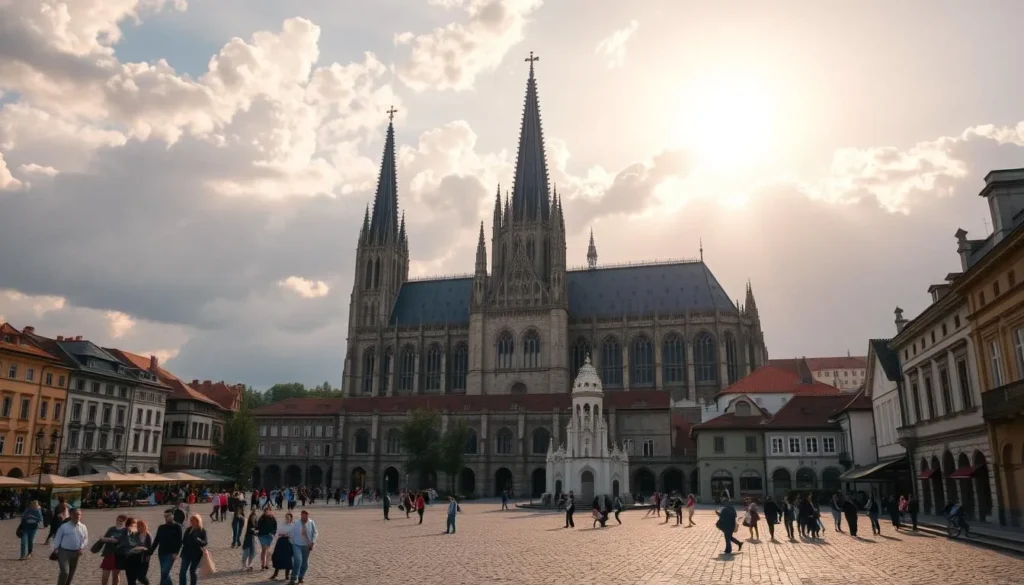
Stroll the Old Town center and scenic squares
Step into the center and let Fő Street guide you past cafés, sculpted doorways, and steady local rhythms.
Fő Street shows Baroque, Classicist, and Romantic façades. Wander its colorful streets for an easy stroll past bakeries and patios ideal for people-watching.

Fő Street: baroque façades, relaxed cafés, and people-watching
This is a calm place where the city’s relaxed atmosphere comes alive. Grab a table, plan your next stop, and enjoy gentle buskers and outdoor seating.
Székesfehérvári Virágóra (Flower Clock) and daily date display
Pause at Országzászló Square to see the Flower Clock, created in 1960. Its mechanism keeps correct time from spring to autumn, and gardeners re-plant the daily date next to the clock.
- Architectural details reward a slow pace—look for stucco flourishes and playful statuary above doorways.
- If you like street photography, the light along these façades is flattering most of the day.
- There are plenty of benches and small green pockets to rest without leaving the historic core.
| Feature | Why visit | Quick tip |
|---|---|---|
| Fő Street | Colorful façades, cafés, and people-watching | Start here for a relaxed walking loop |
| Országzászló Square | Flower Clock with daily planted date | Visit in morning to see replanting |
| Nearby benches | Small green pockets for rest | Great spot to plan the rest of your day |
Unwind in style at Árpád Bath
Step into Art Nouveau calm at Árpád Bath and let mosaic pools and carved cabins slow your pace. The complex opened in 1905 over the Árpád spring, grew in the 1920s, and was carefully restored and reopened in 2010.
Relaxation here blends period elegance with modern comfort. The restored dressing cabins, ornamental tiling, and stucco-work give real character. A Turkish bath features a mosaic-covered pool and a whirlpool for deep muscle relief.
The central pool and a tepidarium lined with mosaic tiles are perfect for a mid-afternoon break. An adjacent building houses a sauna, steam room, and wellness showers so you can tailor your session.
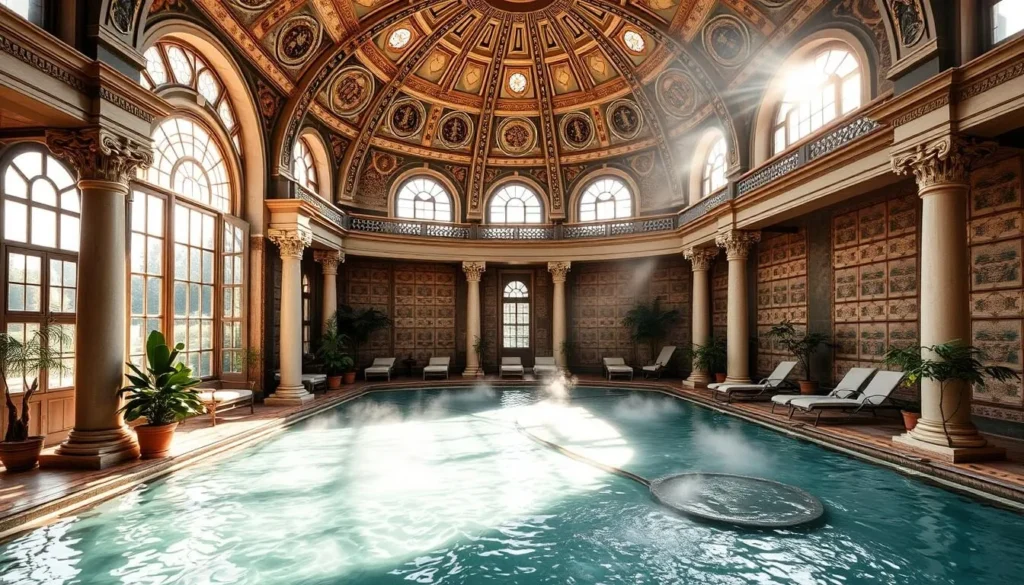
- Visit earlier for quieter rooms, or near closing for a calmer night option.
- Bring a swimsuit and flip-flops; check towel rental to save packing space.
- Pair your time at the bath with a nearby café or an early dinner to keep the evening relaxed.
| Feature | Why visit | Quick tip |
|---|---|---|
| Turkish mosaic pool | Soothe muscles and enjoy historic design | Try the whirlpool after the central pool |
| Tepidarium | Warm baths with decorative tiles | Use as a gentle transition before cool rinse |
| Sauna & steam | Extra wellness options in adjacent area | Combine for a personalized circuit |
Parks and peaceful spots for a breath of fresh air
A small urban oasis near the heart of the city invites you to slow your pace and breathe. This green place is perfect when you want a calm pause between attractions or before your departure.
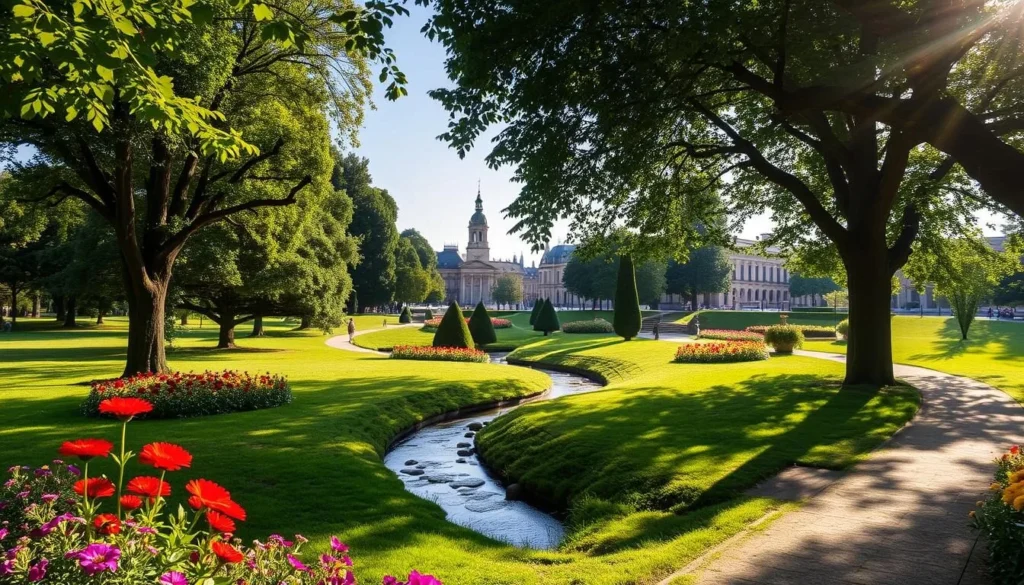
Kings’ Park: a serene green escape
Kings’ Park is the spot to stretch your legs and enjoy shaded paths. Locals love it, and you will find benches, gentle lawns, and quiet corners for a short rest.
Use the park as a buffer in your day — ideal between museum visits or right before a return trip. Early evening brings neighborhood walkers, so you get a glimpse of everyday life away from tourist routes.
- Easy strolls for families and groups splitting up.
- Benches and shaded routes add simple beauty with no planning.
- Bring a coffee and recap highlights while you relax.
- Summer shade makes it a cool break from sun-warmed streets.
| Feature | Why visit | Quick tip |
|---|---|---|
| Shaded benches | Comfortable rest between stops | Perfect for a short time-out |
| Family-friendly paths | Easy strolls for all ages | Meet-up point if your group splits |
| Evening atmosphere | See local life and unwind | Snap a final photo to close your trip |
Eat, drink, and enjoy the night in the city center
After sunset, the center becomes a compact loop of restaurants, pubs, and late-night options. You can plan a relaxed dinner, then hop between cozy bars without long walks.
Book ahead for a relaxed date-night vibe. Try Bányató Vendéglő Kft. or Porto Vino for hearty plates and a warm atmosphere. For a casual bite, Provence önkiszolgáló étterem and Beeráló serve quick, local flavors.
Beli’s Vegan Bistro offers lighter plates if you want a plant-forward option. Kertész Csárda adds homestyle Hungarian dishes—arrive a bit early on busy evenings.
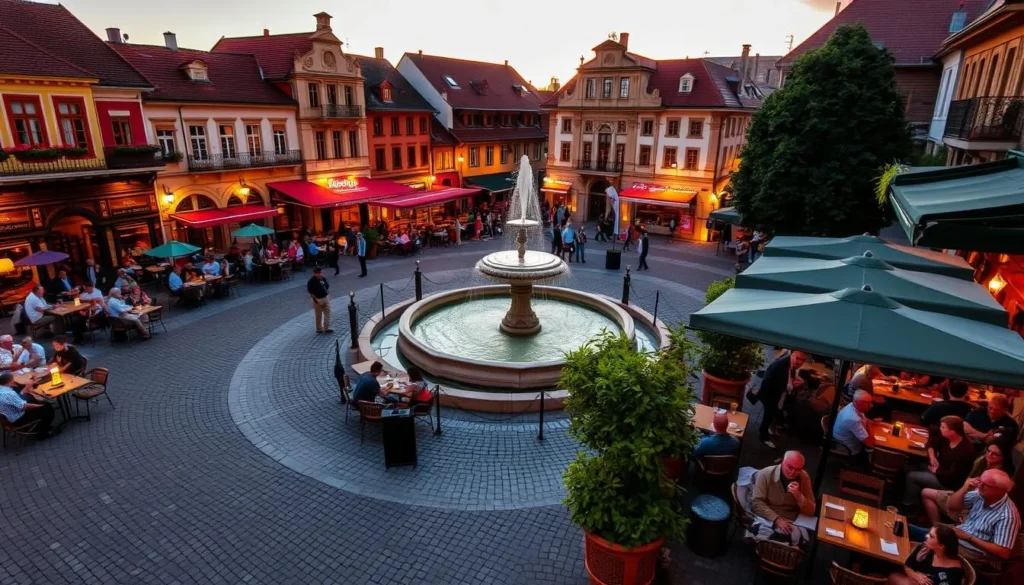
Cozy bars and evening vibes
- Slide into Petz Söröző or Pince Borozó for conversation over beer.
- Varkocs Old Pub gives a classic pub atmosphere, while Borpatika focuses on local wines.
- If you’re with friends, end the night at Five X Bowling Center for a playful change of pace.
| Place | Why visit | Quick tip |
|---|---|---|
| Bányató Vendéglő Kft. / Porto Vino | Hearty meals, date-night atmosphere | Book a table on weekends |
| Provence / Beeráló | Casual, quick local flavors | Great for a short bite between sites |
| Petz Söröző / Pince Borozó | Friendly bars with local drinks | Perfect for after-dinner drinks |
You’ll find plenty of outdoor tables in warm months. Ask about daily specials and finish with a short stroll through the lit squares—an easy, memorable way to end your day and feel a bit at home in the city.
Where to stay, tours, and practical tips
A smart base near the square turns a short visit into an easy, full experience. Choose accommodation close to the Old Town and you save time between sights and meals.
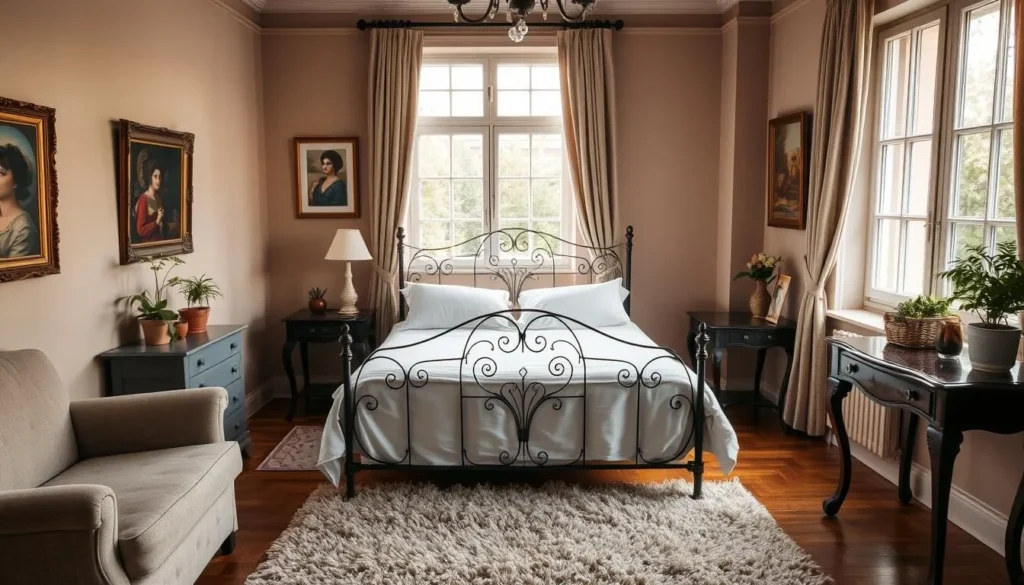
Accommodation options near the center
Well-rated hotels include Mercure Székesfehérvár Magyar Király, Szent Gellért Hotel, and Best Western Plus Lakeside Hotel. Check-in across the country usually starts around 2–3 PM.
If you arrive early, store your bags and begin exploring the streets and squares.
Getting around and timing
The center is very walkable; expect about a 20–25 minute walk from the train station or use local buses when you have luggage. For Bory Castle, catch city buses 26A or 32 and budget extra return time on weekends.
Guided tours, tickets, and entry tips
Museum enthusiasts should pre-book where required (the Clock Museum). Drop by Tourinform at Town Hall for maps, current tours, and access to the certified Holy Crown copy.
- Look for short guided tours of the coronation core — they add context and value.
- Keep some cash for small entries and local bus fares.
- Plan a flexible trip: pick 2–3 timed entries and fill gaps with churches, cafés, and shaded walks.
Conclusion
With short walks between highlights, you can shape a focused day that balances history, baths, and bites.
Start at the royal core — the Ruins Garden, Orb, and Bishop’s Palace — then hop a bus to bory castle for an artist-built surprise. Add small museums and a soothing stop at Árpád Bath for variety.
Frequent trains mean easy travel; the rail link from Budapest takes about 45–60 minutes. Pick a few key attractions, leave room for a café and a late stroll along the streets, and you’ll feel the place’s style without rushing.
If you like context, short tours sharpen what you see. End with dinner in the center and a calm walk home — simple rituals that make the trip stick.
The above is subject to change.
Check back often to TRAVEL.COM for the latest travel tips and deals.
